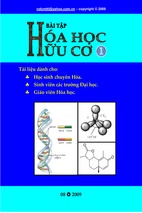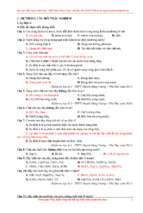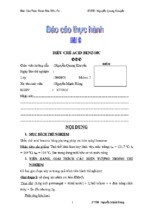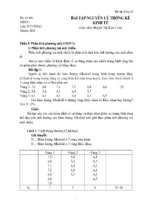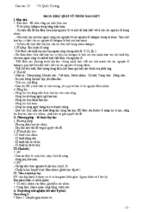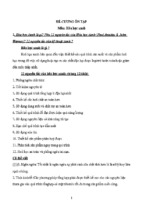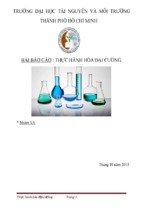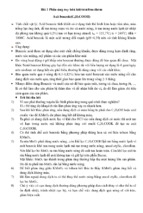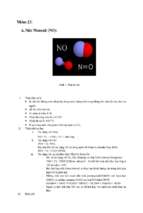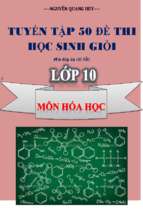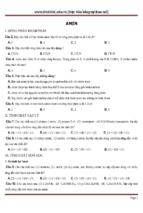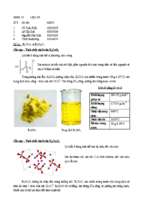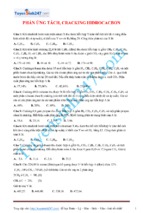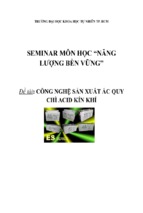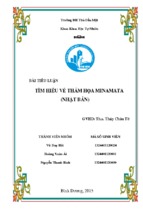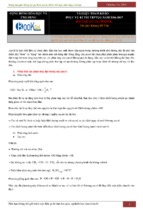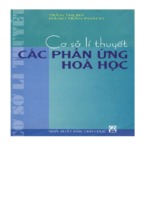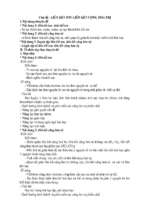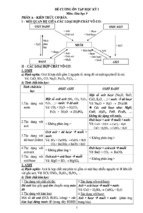>;
8]y
EDWIN RICHARD
GILT.II.ANO
Professor of Chemical Engineering
Afassachusetts Institute of Technology
FOURTH EDITION
SKCOND
McGRAW-HILL BOOK COMPANY,
NKW YORK
TORONTO
1950
INC.
LONDON
ELEMENTS OF FRACTIONAL DISTILLATION
Copyright, 1922, 1930, 1939, 1950, by the McGraw-Hill Book Company, Inc
Printed in the United States of America. All rights reserved. This book, or parti
thereof, may not be reproduced in any form without permission of the publishers
THE MAPLE PRESS COMPANY, YORK,
PA.
PREFACE TO THE FOURTH EDITION
The firs^^ditipn.of-this book and the early revisions were the result
of the efforts of Professor Robinson, and he took an active part in
guiding the revision of the previous edition. His death t made it
necessary to prepare this edition without his helpful guidance and
counsel.
The present revision differs extensively from
The material has been modified to bring it more
the previous edition.
closely into line with
the graduate instruction in distillation at Massachusetts Institute of
Technology. Much greater emphasis has been placed on the measurement, prediction, and use of vapor-liquid equilibria because it is
believed that this is one of the most serious limitations in design calcuGreater emphasis has also been placed upon the use of
lations.
enthalpy balances, and the treatment of batch distillation has been
considerably expanded. Unfortunately, the design calculations for
an unsatisfactory status. Azeotropic
an extension of conventional multicomponent problems.
The sections on column design
and column performance have been completely rewritten and increased
in scope.
In all cases quantitative examples have been given because
it has been found that this greatly aids the student in understanding
this type of operation are
and extractive
still
in
distillation are considered as
descriptive material.
During the last 15 years a large
number of design methods have been
proposed for multicomponent mixtures, some of which are reviewed in
Chapter 12. Most of these do not appear to offer any great advantage
over the conventional Sorel method, and it is believed that the law of
diminishing returns has been applying in this field for some time. It is
hoped that the present edition will stimulate some of these investigators to transfer their efforts to more critical problems, such as
vapor-liquid equilibria, batch distillation, transient conditions within
the distillation system, and column performance.
EDWIN RICHARD GILLILAND
CAMBRIDGE, MASS.
July, 1960
PREFACE TO THE FIRST EDITION
The subject of fractional distillation has received but scant attention from, writers in the English language since Sidney Young published
"
Fractional Distillation " in 1903 (London). French and
his book
German authors have, on the other hand, produced a number of books
on the subject, among the more important of which are the following:
"La Rectification et les colonnes rectificatriccs en distillerie,"
E. Barbet, Paris, 1890; 2d ed., 1895.
"Der Wirkungsweise der Rcctificir und Destillir Apparate,"
E. Hausbrand, Berlin, 1893; 3d ed., 1910.
"Theorie der Verdampfimg und Verfliissung von gemischcn und der
fraktionierten Destination," J. P. Kuenen, Leipzig, 1906.
"Theorie der Gewinnung und Trennung der atherischen Olc durch
Destination," C. von Rechenberg, Leipzig, 1910.
"La
Distillation fractione*e et la rectification," Charles Manlier,
Paris, 1917.
Young's "Fractional Distillation," although a model for its kind,
has to do almost entirely with the aspects of the subject as viewed
from the chemical laboratory, and there has been literally no work in
English available for the engineer and plant operator dealing with the
applications of the laboratory processes to the plant.
The use of the modern types of distilling equipment is growing at
a very rapid rate. Manufacturers of chemicals are learning that they
must
refine their products in order to market them successfully, and
often true that fractional distillation offers the most available
it
is
if
not the only
way of accomplishing this. There has consequently
demand among engineers and operators for a book which
the principles involved in such a way that these principles
arisen a wide
will explain
can be applied to the particular problem at hand.
It has therefore been the purpose of the writer
of this book to
attempt to explain simply yet accurately, according to the best ideas of
physical chemistry and chemical engineering, the principles of fractional distillation, illustrating these principles with a few carefully
This book is to be regarded neither as a comselected illustrations.
plete treatise nor as an encyclopedia on the subject but, as the title
indicates, as an introduction to its study.
PREFACE TO THE FIRST EDITION
Viii
In general, it has been divided into five parts. The first part deals
with fractional distillation from the qualitative standpoint of the
phase rule. The second part discusses some of the quantitative
Part three
aspects from the standpoint of the chemical engineer.
discusses the factors involved in the design of distilling equipment.
Part four gives a few examples of modern apparatus, while the last
tables which have been
portion includes a number of useful reference
and
unavailable except in
of
out
sources
from
print
mostly
compiled
large libraries.
The writer has
some
at will on the several books mentioned above,
taken nearly bodily from them, and has also
"
from
Findlay's Phase Rule" (London, 1920) and
help
drawn
of the tables being
derived
much
from "The General Principles
of
Chemistry" by Noyes and
Sherrill
He
wishes especially to express his gratitude for
(Boston, 1917).
the inspiration and helpful suggestions from Dr. W. K. Lewis of the
Massachusetts Institute of Technology and from his other friends and
and of the E. B. Badger & Sons Company.
to
wishes
he
express his appreciation of the assistance of
Finally,
Miss Mildred B. McDonald, without which this book would never
have been written.
associates at the Institute
CLARK SHOVE ROBINSON
CAMBRIDGE, MASS.
June, 1920,
CONTENTS
PREFACE TO THE FOURTH EDITION
v
.
PREFACE TO THE FIRST EDITION
vii
INTRODUCTION
1
.3
1.
Determination of Vapor-Liquid Equilibria.
2.
Presentation of Vapor-Liquid Equilibrium Data
3.
Calculation of Vapor-Liquid Equilibria
4.
Calculation of Vapor-Liquid Equilibria (Continued)
5.
General Methods of Fractionation
6.
Simple Distillation and Condensation.
107
7.
Rectification of Binary Mixtures.
118
8.
Special Binary Mixtures
/9/ Rectification
10.
i^l.
of
16
.26
.79
.
.
.
.
.
101
.
.
192
.
Multicomponent Mixtures
Extractive and Azeotropic Distillation
Rectification of
.
.
.
.
Complex Mixtures
.
...
...
.
,
.
....
12.
Alternate Design Methods for Multicompt onent Mixtures
13.
Simultaneous Rectification and Chemical Reaction.
14.
Batch
15.
Vacuum
.
,
.
214
285
325
336
361
370
Distillation
393
Distillation
16. Fractionating
Column Design
403
17. Fractionating
Column Performance
445
18. Fractionating
Column
471
Auxiliaries
APPENDIX
479
INDEX
481
ix
INTRODUCTION
Definition of Fractional Distillation. By the expression fractional
was originally meant the process of separating so far as it
a mixture of two or more volatile substances into its
be
feasible
may
distillation
components, by causing the mixture to vaporize by suitable application
way that fractions of varying
of heat, condensing the vapors in such a
boiling points are obtained, re vaporizing these fractions and separating
their vapors into similar fractions, combining fractions of similar boiling points, and repeating until the desired degree of separation is finally
obtained.
Such a process is still occasionally met with in
chemical
the
laboratory, but it is a laborious and time-consuming
has its chief value as a problem for the student, for the
which
operation
purpose of familiarizing him with some of the characteristic properties
It is possible to carry on a fractional distillaof volatile substances.
mechanical devices which eliminate almost all
certain
of
tion by means
of this labor and time and which permit separations not only equal to
those obtained by this more tedious process but far surpassing it in
Purpose of Book.
The purpose of this book is to indicate
quality and purity of product.
be
how such devices may
profitably used in the solution of distillation
problems.
Origin of Fractional Distillation. Like all the older industries,
fractional distillation is an art that originated in past ages and that
developed, as did all the arts, by the gradual accumulation of empirical
knowledge. It is probable that its growth took place along with that
of the distilled alcoholic beverages, and to the average person today
the word "still" is synonymous with apparatus for making rum,
brandy, and other distilled liquors. To France, which has been the
initial development
great producer of brandy, belongs the credit for the
of the modern fractionating still.
Physical Chemistry and Fractional Distillation. Fractional distillation has labored under the same sort of burden that the other
industrial arts have borne.
Empirical knowledge will carry an
then further advances are few and far
and
certain
a
to
point,
industry
between. It has been the function of the sciences to come to the rescue
1
FRACTIONAL DISTILLATION
2
and thus permit advancement to greater usescience that has raised fractional distillation from an
of the arts at such times
fulness.
The
empirical to a theoretical basis is physical chemistry. By its aid the
study of fractionation problems becomes relatively simple, and it is on
this
account that the subject matter in this book
chemistry.
is
based upon physical
CHAPTER
1
DETERMINATION OF VAPOR-LIQUID EQUILIBRIA
The separation of a mixture of volatile liquids by means of fractional
distillation is possible when the composition of the
vapor coming from
the liquid mixture is different from that of the liquid. The separation
the easier the greater the difference between the composition of the
vapor and that of the liquid, but separation may be practicable even
when the difference is small. The relation between the vapor and
liquid compositions must be known in order to compute fractional disis
relationships.
Usually this is obtained from information
concerning the composition of the vapor which is in equilibrium with
the liquid. On this account a knowledge of vapor-liquid equilibrium
compositions is usually essential for the quantitative design of fractional distillation apparatus.
In most cases the study is made on the
basis of the composition of the vapor in equilibrium with the liquid.
However, this is not a fundamental requirement and any method that
would allow the production of a vapor of a different composition than
that of the condensed phase, whether equilibrium or not, could be used
for separation.
However, most of the equipment employed depends
on the use of a vaporization type of operation, and the equilibrium
vapor is a good criterion of the possibilities of obtaining a separation.
tillation
The methods for obtaining vapor-liquid equilibrium compositions
can be considered in two main classifications: (1) the experimental
determination of equilibrium compositions and (2) the theoretical
relationships.
EXPERIMENTAL DETERMINATIONS OF VAPOR-LIQUID EQUILIBRIA
The measurement of vapor-liquid equilibrium compositions is not
A highly developed laboratory technique is therefore needed
simple.
to obtain reliable data in any of the several methods described here.
Circulation Method.
common method for obtaining vapor-liquid
equilibrium (Refs. 11, 13, 16, 23, 27, 35) is by circulating the vapor
through a system and bringing it into repeated contact with the
liquid until no further change in the composition of either takes
schematic diagram of such a system is shown in Fig. 1-1.
place.
The vapor above the liquid in vessel A is removed, passed through
A
A
3
FRACTIONAL DISTILLATION
chamber 5, and recirculated by pump C through the liquid in A.
While the system appears simple, in actual practice it involves a number of complications:
The system must be completely tigkt; otherwise the total quanof
material will continually vary and the equilibrium compositions
tity
of the vapor and liquid will also change.
1.
2. The quantities of liquid and of vapor when equilibrium is obtained
must remain constant and not vary during the recirculation. To keep
--Vapor sample
Heat-*
exchanger
Equilibrium
I
cell
Circulation apparatus for vapor-liquid equilibrium measurements.
FIG. 1-1.
it is necessary for the system to remain isothermal and
volume to remain constant. The chief variation in the
volume of the system is due to the fact that it is usually found expedient
The error due to this variation is usually
to use a reciprocating pump.
minimized by making the displacement volume of the pump small.
them constant
for the total
The pumps
column
is
are generally of a mercury-piston type; t.e., a mercury
forced up and down in a steel or glass cylinder serving
as the piston of the
tially leakproof
pump.
pump and
This makes
allows the
it possible to have an essenpumping operation to be carried
out with very little contamination of the circulating vapors.
3. This type of system has been used most successfully under con-
DETERMINATION OF VAPOR-LIQUID EQUILIBRIA
5
ditions where the vapor does not condense at room temperature.
If
were necessary to operate the pumping system at a high temperature
it
to avoid condensation of the vapor, difficulties might be encountered
due to the vapor pressure of the mercury, in which case other lower
vapor pressure metallic liquids should be suitable.
4. Another condition that could cause the relative volumes
of vapor
vary is the rate of flow. The rate of recirculation
varies the pressure drop through the apparatus and thereby changes
the quantity, of vapor present. In most cases the rate of recirculation
is such that the pressure differential for recirculation is not great.
Both the volume variation due to pumping and the pressure changes
due to recirculation can be made less detrimental by making the vol-
and
of liquid to
A
ume
of the liquid in vessel
large.
5. It is necessary to ensure that there
is no entrainment of liquid
with the vapor leaving A. If liquid is carried over to vessel B, the
vapor sample will be contaminated. This entrainment is eliminated
by the use of low velocity and by efficient entrainment separators in
the upper part of A.
6. Another precaution is the necessity to prevent any condensation
If any vapor condenses, the conof the vapor during recirculation.
densate will be of different composition and the results will be in error.
This type of apparatus has been used for a variety of systems.
It is particularly suitable for very low temperature studies such as
those involved in the equilibria associated with liquid air. In this
case vessel A is maintained in a low-temperature cryostat, and the
heat-exchanged with the exit vapor; the rest
One of
of the system is maintained at essentially room temperature.
the
fact
that
vapor sample is
the difficulties with the operation is the
is
high, the quantity of
obtained as a vapor and, unless the pressure
as
to offer difficulties in
small
be
so
B
may
vapor obtained in vessel
recycle vapor stream
is
analysis.
great 'ad vantage that a vapor can be repeatedly
Theoretically
bubbled through the liquid until equilibrium is obtained.
there are
fact
that
the
of
because
obtained
not
is
exact equilibrium
at the
Thus
the
entering
in
the
vapor
system.
pressure differentials
the
than
A,
leaving
a
vapor
under
be
A
must
higher
of
bottom
pressure
at least by an amount equal to the hydrostatic head of the liquid in A.
Since the vapor-liquid equilibria depend on pressure, it is obvious that
there cannot be exact equilibrium. However, the change in the
due to this small change of prescomposition of the equilibrium vapor
sure is small in most cases. It could be serious in the critical region
The system has the
FRACTIONAL DISTILLATION
Basically this system is one of
true
the best for obtaining
equilibrium.
Bomb Method. In the bomb method (Refs. 3, 4, 12, 14, 36) the
where the vapor
is
very compressible.
It is then agitated
is placed in a closed evacuated vessel.
at
constant
other
or
temperature until equilibmeans,
by
by rocking,
rium is obtained between the vapor and the liquid. Samples of the
liquid sample
vapor and the liquid are then withdrawn and analyzed.
The method appears simple, but it involves certain difficulties.
During sampling there are pressure changes due to the removal of
In
material, and these pressure changes can be large in magnitude.
order to avoid them, it is customary to add some fluid, such as mercury,
to the system while the samples are being
removed
in order to prevent
Rocking
mechanism
-
-
fjf
FIG. 1-2.
Bomb
Sampling
line
Constant temperature
apparatus.
any vaporization or condensation. Another difficulty with the
method is the fact that in most cases it is necessary to use sampling
These may fill up with liquid during the
lines of small cross sections.
initial part of the operation, and this liquid may never come to the true
It is necessary to purge the sampling lines to remove
equilibrium.
such liquid. This liquid holdup is particularly serious in the case of
the vapor sample since in quantity it may be large in comparison to the
sample. A schematic diagram of the bomb-type apparatus is shown
in Fig. 1-2.
Dynamic Flow Method. Another method that has been widely
used (Refs. 10, 21, 25, 37) for the determination of vapor-liquid equilibria is one in which a vapor is passed through a series of vessels conThe vapor entering the
taining liquids of a suitable composition.
first vessel may be of a composition somewhat different from the
equilibrium vapor, but as it passes through the system it tends to
approach equilibrium, If all the vessels have approximately the same
liquid composition, the vapor will more nearly approach equilibrium
as it passes through the unit, The number of vessels employed should
be suoh that the vapor entering the
rium composition.
last unit is of essentially equilib-
DETERMINATION OF VAPOR-LIQUID EQUILIBRIA
7
This system has the advantage that it is simple and, in certain cases,
possible to dispense with the analysis of the liquid sample, i.e., the
liquids can be made of a known composition, and since the change in
it is
the last vessel is small, it is possible to assume that the composition of
the liquid in this case is equal to that originally charged. A schematic
diagram of such a system is shown in Fig. 1-3.
it cannot be an exact equilibrium system because
a pressure drop is involved in passing the vapor through
the system; i.e., there are pressure variations which will affect equiThere is also the danger of entrainment, although this can
librium.
be minimized by low velocities.
In a great many cases, the gas introduced into the first vessel has
.been carrier gas of low solubility and not a component of the system.
It is
obvious that
of the fact that
FIG. 1-3.
Dynamic
flow method.
Thus, in the determination of the vapor-liquid equilibria for systems
such as ammonia and water, ammoniacal solutions are placed in the
vessels, and a gas such as nitrogen is bubbled into the first of these and
the resulting nitrogen-ammonia-water vapor mixture is passed through
the succeeding vessels obtaining a closer approach to equilibrium.
Equilibrium obtained in such a manner is not the true vapor-liquid
It closely approaches
equilibria for the water vapor-ammonia system.
true equilibrium for the binary system under a total pressure equal to
the partial pressure of the ammonia and the water vapor in the gaseous
some solubility
added
constituents
these
of
partial pressure
modifies the energy relations of the liquid and vapor phases. Usually
for low-pressure operation these errors are not large in magnitude, but
mixture.
Even
this is not exact.
in the liquid phase,
The
carrier gas has
and the
as the pressure becomes higher the errors are serious and the method
can give erroneous results if the true vapor-liquid equilibria for mixtures without the carrier gas are desired.
Dew and Boiling-point Method. In essence this technique consists
in introducing a mixture of known composition into an evacuated
equilibrium container of variable volume (Refs. 6, 7, 9, 15, 17, 18, 20,
The system is maintained at a constant temperature, and by
28).
the volume the pressure is observed at which condensation
varying
- Xem thêm -

